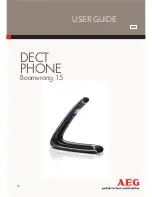
Safety Information
Please carefully read the terms below:
Use Safely
Do not use the phone in situations where it might cause danger.
Transportation Safety
Please observe all transportation laws and regulations.
Please drive with both hands on the wheel.
PLEASE DRIVE RESPONSIBLY - DO NOT TEXT AND DRIVE
Hospital Safety
Please follow hospital rules and limitations.
Please turn off your mobile phone when near medical instruments.
Airport Safety
Remember to follow all airport and flight safety regulations.
Chemical Warning
Do not use your mobile phone around fuels or chemicals.
Temperature Warning
Do not subject your phone to extreme temperature conditions.
Water Hazard
Your phone is not waterproof. Keep your phone away from water or liquid to avoid damage.
Emergency Calls
Make sure your mobile phone is switched on and in a service area. In home screen, tap the phone key and dial
the emergency number.
Accessories and Batteries
Use only BLU authorized batteries and accessories.
Information Backup
Remember to keep a written record of important information.
Battery Safety and Precautions
• For better performance and longer battery life, it is recommended that you charge the battery fully before
using the mobile phone for the first time.
• The optimum performance of a new battery is typically achieved after two or three complete charge cycles.
Note: Keep in mind that continuous overcharging will affect long-term battery life.
• While charging, keep the mobile phone out the reach of children.
• Store the battery in a cool and dry place away from direct sunlight and water.
• Do not expose batteries to extreme temperatures (below -8°C (18°F) or above 43°C (110°F).
• Immediately stop using the battery if it produces an odor, cracks and leaks, overheats, distorts or has any
other type of physical damage.
• Avoid using the charger near or around liquids. If the charger is exposed to water or any liquids, immediately
unplug it from the outlet to reduce the risk of overheating, charger malfunction, electric shock or fire.
Hazardous Waste – Battery Disposal
Warning: Do not throw away batteries with uncontrolled daily waste.
The marking in this manual indicates that the batteries in this product should not be disposed
with household trash at the end of its working life. If the batteries are not disposed of properly,
the substances included can cause harm to human health and the environment. Please follow
environmental laws and guidelines for proper waste disposal.
Cleaning and Maintenance
• Avoid using the handset and accessories in excessively moist areas to avoid malfunction.
• Use a soft, dry cloth to clean the handset, battery and charger.
• Do not use alcohol, thinner, benzene or any other solvent to clean the handset.
Safety precautions for power supply unit
Use the correct external power source
A product should be operated only from the type of power source indicated on the electrical ratings label. If
you are not sure of the type of power source required, consult your authorized service provider or local power
company. For a product that operates from battery power or other sources, refer to the operating instructions
that are included with the product.
This product should be operated only with the following designated power supply unit(s)
Travel charger: Input: 100-240V, 50/60Hz, 0.2A(input current Limiting). Output: 5V, 1000mA (Rate Current).
Handle battery packs carefully
This product contains a Lithium-ion battery. There is a risk of fire and burns if the battery pack is handled
improperly. Do not attempt to open or service the battery pack. Do not disassemble, crush, puncture, short circuit
the external contacts or circuits, dispose of in fire or water, or expose a battery pack to temperatures higher than
104°F (40°C). The operating temperature for the phone is -14°F (-10°C) to 104°F (40°C). Warning: Danger of
explosion if battery is incorrectly replaced.
To reduce risk of fire or burns, do not disassemble, crush, puncture, short circuit the external contacts, expose
to temperature above 104°F (40°C), or dispose of in fire or water. Replace only with specified batteries. Recycle
or dispose of used batteries according to the local regulations or reference guide supplied with your product.
Take extra precautions
• Do not disassemble or open crush, bend or deform, puncture or shred.
• Do not short circuit a battery or allow metallic conductive objects to contact battery terminals.
• The phone should only be connected to products that bear the USB- IF logo or have completed the USB-IF
compliance program.
• Do not modify or remanufacture, attempt to insert foreign objects into the battery, immerse or expose to
water or other liquids, expose to fire, explosion, or other hazards.
• Battery usage by children should be supervised.
• Only use the battery for the system for which it is specified.
• Only use the battery with a charging system that has been qualified with the system per CTIA Certification
Requirement for Battery System Compliance to IEEE1725. Use of an unqualified battery or charger may
present a risk of fire, explosion, leakage, or other hazards.
• Replace the battery only with another battery that has been qualified with the system per this standard,
IEEE-Std-1725. Use of an unqualified battery may present a risk of fire, explosion, leakage, or other hazards.
• Promptly dispose of used batteries in accordance with local regulations.



































